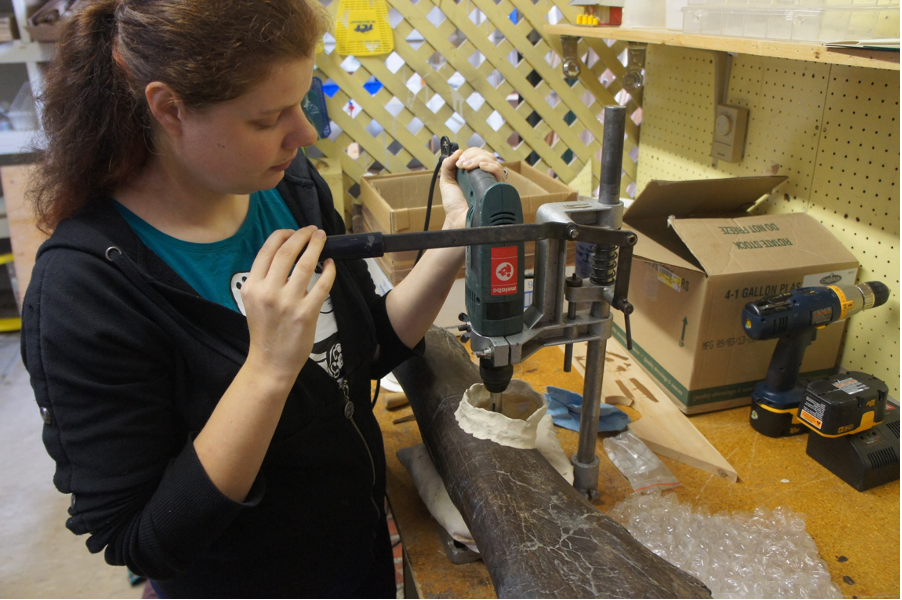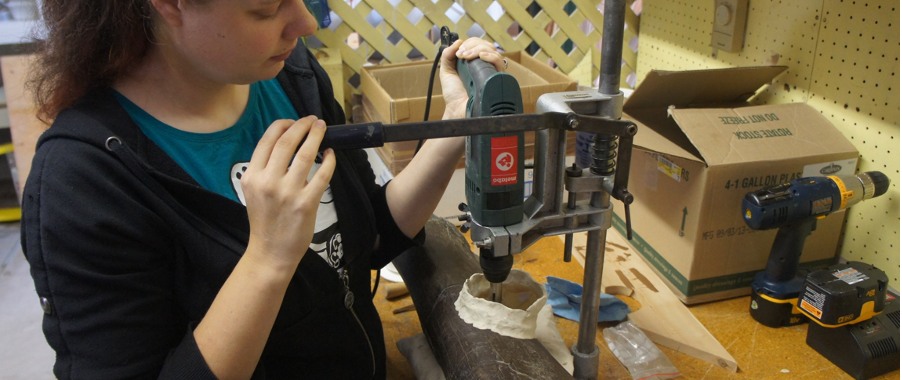
CMC Blog
That can’t be good! (for a fossil)
By: Glenn W. Storrs, Ph.D., Withrow Farny Curator of Vertebrate Paleontology
Vertebrate fossils are typically rare and often have great scientific import for interpreting the history of life on Earth. They are protected in many jurisdictions by local, state or federal law and are coveted by museums. Cincinnati Museum Center’s Vertebrate Paleontology Collection is the largest in our region, containing tens of thousands of individual fossils, ranging from tiny teeth and scales to entire dinosaur skeletons. Its holdings are particularly strong in regional Pleistocene (“Ice Age”) animals, mid-continental Paleozoic fossils (fish and “amphibians”) and Jurassic dinosaurs of the U.S. Western Interior.
Why then would anyone want to damage a fossil bone by removing a section of it with a power drill as shown in the accompanying photo? Isn’t that against all tenets of collections care, whereby a museum is responsible for maintaining and protecting its objects? Surely this must be a wanton act of vandalism!
In fact, collections, especially scientific collections exist to be used. They may be used for exhibit or education, but a major use is in the furtherance of research. Many specimens are not such that they would be particularly interesting for the general public to see on exhibit, but each represents a data point in the global scientific database. On occasion, if a research question is pressing enough and presented to the responsible curator with enough justification, a researcher may be allowed to conduct “destructive analysis.” This means that a small portion of the specimen may be destroyed or altered in such a way that a part of the whole is lost.
Examples of destructive analysis in fossils (or other collection pieces) can include the pulverization and “burning,” “disaggregation” or “dissolution” of a small fragment for chemical analysis, isotopic study or radiometric dating, etc. In each case, the fragment will not return to the collection, but the curator will expect a report of the analysis, and/or a copy of the scientific publication that results, for the collection records. The loss of a specimen or small portion thereof will have led to the addition of new information about that specimen and thus create greater scientific worth for the object/collection.
Sometimes specimens are dissected or sectioned in some way. In the case of fossil bones, sawing or drilling through a specimen, followed by microscopic examination, can elucidate the internal structure (histology) of the bone and perhaps lead to conclusions about the physiology or age of the animal to which it belonged. The image shows a researcher from Germany’s University of Bonn, Kayleigh Wiersma, removing a core from the shaft of a dinosaur bone with a specially designed drilling apparatus. Kayleigh visited Cincinnati Museum Center’s Geier Collection & Research Center in 2016 to take several samples – with permission! – in order to learn about the age and growth rates of the small sauropod dinosaurs (apparently young Diplodocus) that have been collected by CMC in Montana. The results of this study, now underway, are eagerly awaited!
So then, sometimes the seemingly counter-intuitive “damage” done to a specimen can be good, in spite of all appearances to the contrary!

Kayleigh Wiersma, of The University of Bonn, collects a core sample from a Jurassic sauropod limb bone using a power drill. The clay “dam” around the drill site holds a small pool of water to lubricate and cool the bit.
Museum Admission
Includes Cincinnati History Museum, Museum of Natural History & Science and The Children's Museum
| Adult: | $22.50 |
| Senior: | $15.50 |
| Child: | $15.50 |
| Member Adult: |
FREE |
| Member Child: |
FREE |
Members receive discounts!
Become a Member today to save on programs, exhibits and films throughout CMC.
Museum Hours
Open Thursday – Monday
10 a.m. to 5 p.m.
Closed Tuesday and Wednesday
Closed Thanksgiving Day and Christmas Day
Member’s-only early entry: Saturdays at 9 a.m.
Customer Service Hours:
Monday – Sunday, 9 a.m. to 5 p.m.

